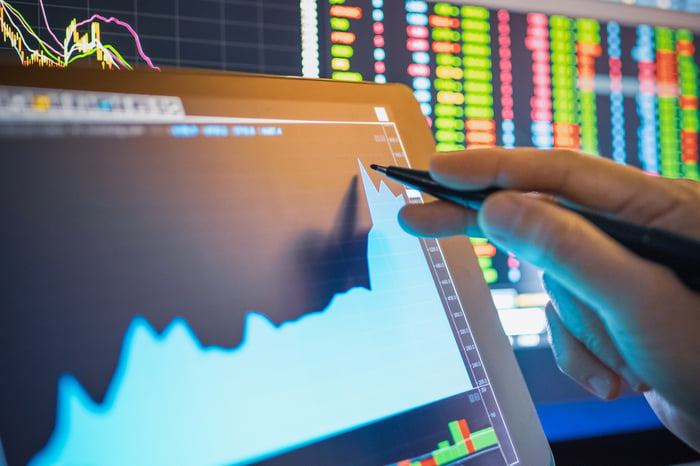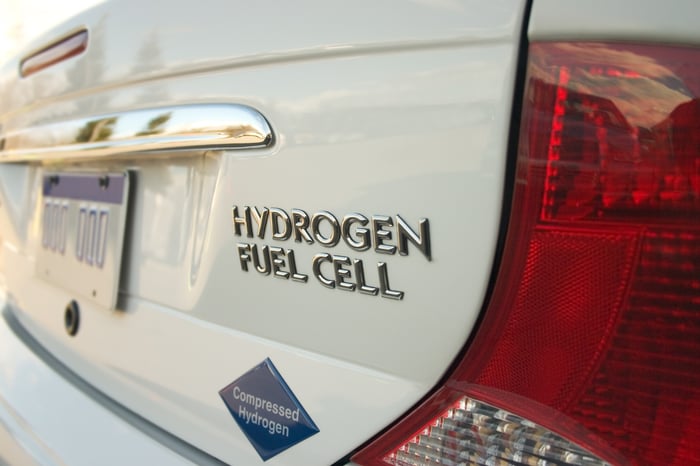Time and again, investors have learned the power of patience on Wall Street. Despite the benchmark S&P 500 losing 34% of its value in roughly a one-month stretch during the first quarter of 2020, the index has completely erased its decline and effectively doubled in value since finding a bottom.
What you might find surprising is that, according to some analysts and investment banks on Wall Street, the upside for certain stocks isn't anywhere near complete. Based on the highest issued price target from Wall Street for the following five ultra-popular stocks, investors could double, or even triple, their money.

Image source: Getty Images.
Nio: Implied upside of 125%
The first extremely popular stock investors can't stop eyeing or buying that has a lofty price target applied by Wall Street is China-based electric-vehicle (EV) manufacturer Nio (NIO 6.18%). With a currency-converted top-end target of about $92 a share, Nio could drive investors to a 125% return, if this price target proves accurate.
The Nio growth story has both macro and micro tailwinds. On a macro basis, China is the largest auto market in the world, and is therefore the top opportunity for auto stocks to benefit from a multi-decade vehicle replacement shift to EVs. With the country's EV industry still nascent, there's plenty of market share up for grabs.
On a company-specific basis, Nio has built up an impressive cash hoard and has demonstrated that it can ramp up production. Even with a global chip shortage, Nio delivered almost 21,900 EVs in the second quarter. It looks to be well on its way to producing an annual run-rate of 150,000 EVs, once chip supply issues are resolved.
What's more, Nio introduced its battery-as-a-service program last year, which should improve customer loyalty and trade some near-term revenue for higher long-term operating margins.
Although $92 a share is a bit aggressive for a company that's only delivered around 125,500 EVs since its inception, Nio's growth trajectory is certainly headed in the right direction.

Image source: Getty Images.
Canopy Growth: Implied upside of 126%
Another ultra-popular company that at least one Wall Street firm remains very bullish on is Canadian marijuana stock Canopy Growth (CGC 2.31%). If the loftiest price target of 51 Canadian dollars ($40.70 U.S.) were to become a reality, Canopy Growth would rocket higher by 126%.
The optimism surrounding the company probably has to do with its leading market share in the Canadian weed industry, as well as its massive cash war chest. According to the company, it maintained a 15.2% share of weed sales in tracked provinces in the calendar second quarter. That's an impressive figure given how competitive the Canadian cannabis landscape has become over the past three years.
Furthermore, Canopy Growth ended June with CA$2.05 billion in cash and cash equivalents, which means it has more than enough capital to continue executing on its strategy. If you're wondering why it's so flush with cash, look no further than multiple direct equity investments from spirits giant Constellation Brands.
However -- and this is a big "however" -- the Canadian pot industry and Canopy Growth have been an utter disaster since marijuana was legalized in October 2018. Canadian regulators threw cold water on the industry by delaying cultivation and sales license applications. Meanwhile, Canopy Growth did itself no favors by over-expanding its production capacity and grossly overpaying for acquisitions. The bottom line is that Canopy Growth has burned through close to CA$3 billion in cash in less than three years, which makes a CA$51 price target highly unlikely.

Image source: Getty Images.
Penn National Gaming: Implied upside of 113%
Wall Street also appears to be rolling the dice on gaming and sports betting company Penn National Gaming (PENN 0.22%). The highest Wall Street price target forecasts that Penn National will head to $151 a share, which would represent a cool 113% return from where it closed the previous week.
Penn's overwhelming success since the pandemic struck can be tied to two key factors. First, it owns 43 gaming or horse-racing properties in 20 states. Whereas most casinos were pulverized by the pandemic, Penn National escaped much of this pain since its properties aren't located solely in tourist destinations. In other words, Penn's gaming properties encourage local foot traffic, which is one reason it's so successful.
Arguably the bigger reason Penn has been on fire since the pandemic began is the 36% equity stake it took in online sports-betting service Barstool Sports in February 2020. With people staying home due to the pandemic, some turned to online sports wagering and fantasy sports betting for entertainment.
With online sports betting offering sustainable double-digit growth potential, and Penn National's gaming properties well-insulated from the turmoil hitting regions like Las Vegas and Macao, it has a reasonable chance to eventually hit Wall Street's loftiest price target.

Image source: Getty Images.
JD.com: Implied upside of 108%
At least one Wall Street analyst is buying into the JD.com (JD -0.22%) growth story. Even with Chinese regulators cracking down on domestic tech companies, the highest price target on Wall Street implies up to 108% upside for China's second-largest e-commerce stock.
Perhaps one reason analysts feel so comfortable with JD is the company's markedly different operating model from Alibaba, China's leading e-commerce company. Alibaba primarily operates as a third-party online marketplace, and was hit with a record $2.8 billion antitrust fine from Chinese regulators this past April.
Meanwhile, JD almost exclusively sells goods directly to Chinese consumers. This means it operates an Amazon-like business model, whereby it controls its inventory and logistics. This makes it far less likely that JD falls under the microscope of Chinese regulators.
The great thing about JD is that it's expanded its reach beyond just e-commerce. More specifically, it's generating revenue from advertising, healthcare services, and cloud services. The latter is particularly intriguing given that cloud margins are substantially higher than online retail margins. Though these ancillary services only accounted for 14% of the company's total sales in the first quarter, services revenue skyrocketed 73%.
While the near term could remain uncertain for JD, it has a solid foundation in place to eventually double shareholders' money.

Image source: Getty Images.
Plug Power: Implied upside of 212%
The final ultra-popular stock that Wall Street believes has incredible upside is hydrogen fuel-cell solutions provider Plug Power (PLUG 3.81%). Based on the most aggressive price target of $78, Plug Power could climb 212%, compared to where it closed last week ($24.99).
The bull thesis for Plug Power is very similar to that of Nio. Namely, we're witnessing a shift away from combustion-engine vehicles and toward green energy-powered vehicles. This shift won't happen overnight, but will instead provide a multi-decade opportunity for consumers and businesses to make the shift.
Plug Power really excited investors in January when the company forged two significant joint ventures just a few days apart. First, SK Group took a 10% equity stake in Plug Power, with the intent of working with Plug to bring hydrogen fuel-cell-powered cars and refilling stations to South Korea. Days later, Plug linked up with French automaker Renault to launch Hyvia, which'll target Europe's light commercial vehicle market.
At this point, there's little doubt that Plug Power's sales growth will impress for years to come. Between 2020 and 2024, the company anticipates growing its gross billings from $337 million to about $1.7 billion. The real question is whether investors can support a large valuation without profits. Until Plug Power makes the turn to recurring profitability, a $78 price target is probably out of the question.





